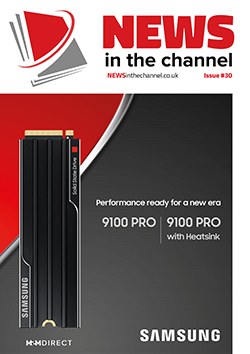Getting employees the right peripherals to help them do their job effectively can make a big difference to productivity for a business – and they can also make a difference to the bottom line for resellers too.
Recruitment for businesses can be expensive and time-consuming, so holding onto good employees is something many businesses look to do and having the right peripherals can make a big difference to employee satisfaction and efficiency.
“Jon Peddie Research reported a 42% productivity increase when users worked with two monitors – highlighting a clear return on investment for organisations equipping staff properly,” says Rory Morgan, EMEA sales and marketing director at Kensington.
“Multi-screen setups require supporting peripherals like docking stations, mice, keyboards and ergonomic gear. We’re seeing growing demand for more sustainable peripherals and specialist ergonomic products such as split keyboards and vertical mice, driven by employee requests for more comfort and support.”
James Campanini, head of Logitech for Business UK and Ireland, adds that providing employees with the right tools to do their job is no longer just a ‘nice to have’, but essential to employee satisfaction and productivity. “Ergonomic devices like keyboards and mice reduce strain and help employees stay focused,” he explains. “For remote and hybrid teams, investing in quality equipment shows employees they’re valued, boosting morale and retention.
“As the workplace evolves, businesses must upgrade peripherals to create more efficient, engaging environments. Employees are no longer settling for ‘basic’ tools. Instead, they expect equipment that enhances comfort and keeps them connected, whether that’s a high-res webcam for seamless collaboration or a wireless headset with noise cancellation to maintain focus in busy settings. These tools are essential for flexible work, helping reduce distractions while enabling people to perform at their best, wherever they are.”
James Reed, managing director – Endpoint Solutions, UK and Ireland at TD SYNNEX, adds that co-workers are always going to feel more valued and more motivated if they have really good screen and desktop devices that allow them to work quickly and comfortably. “It can also have an impact on their health – providing stand-up desks as an option for example, could be important for some co-workers,” he says.
Trends
There are various trends from businesses regarding peripherals sales into offices currently. “In offices, there’s a noticeable trend toward upgrading peripherals not just for performance, but to create more appealing and functional work environments,” says Rory.
“With the rise of hot desking, businesses need universal peripherals that work across mixed hardware estates, ensuring consistency and satisfaction for employees using shared setups. Clean desk aesthetics and wireless solutions are especially popular.”
Meanwhile, for the many hybrid workers around the country, there is still demand for peripherals, although as Rory notes while the initial wave of hybrid work upgrades has passed, demand hasn’t disappeared. “Many organisations are now managing Windows 11 upgrades, which will drive a new round of device purchases – and with those, the need for updated peripherals,” he explains. “Hybrid workers still need thoughtful equipment like privacy screens and portable gear that supports moving between workspaces and working on the go.”
James Reed agrees that home workers want to have just as good an experience in their domestic environment as they do in the office. “While there was a surge in activity during the pandemic to upgrade home set-ups, the momentum has carried though and hybrid working is here to stay,” he says. “There is a good opportunity here to draw the customer’s attention to the positive impact investing in good peripherals can have on home workers’ productivity and morale.”
He adds that users want to make their office environment as appealing as they can. “Having the right equipment on the desktop and around it makes a huge difference, especially when we are all spending such a lot of time on video calls,” he says.
This extends past desks and into meeting rooms, he adds. “The meeting room is another area that needs to be equipped with the best peripherals and furniture that the business can afford. Having really well-equipped meeting spaces creates a positive impression, not only on co-workers, but also on customers, partners and suppliers who are on the other end of those video calls.”
Mike Barron, UK managing director at SYNAXON, adds that the rise in hot desking is also creating opportunities. “Those hot desk workstations need to be equipped with everything that any worker that makes use of them might need,” he says. “There is also greater awareness of ergonomics and the beneficial effects that using a good quality display, keyboard and mouse – and having the whole desktop properly set up – can have on the health and wellbeing of users. All these trends expand the potential for sales of peripherals.”
Wellness upgrades
Indeed, as companies take a more holistic approach to employee care, peripherals can be positioned as wellness upgrades, according to James Campanini. “Features like ergonomic design, quiet performance, and sustainable materials all help build healthier, more productive workspaces,” he says.
“While constant connectivity is a hallmark of the digital workplace, it also brings distractions that affect attention spans, increase stress and reduce the quality of work. Smart peripherals that support focused work can help create calmer, more productive environments.
“Wellness and sustainability are also top of mind, with users seeking products that support health and align with environmental values. These choices reflect a broader shift: businesses are recognising that a well-supported workforce is more engaged and less prone to burnout. In a tech landscape, where frequent upgrades are the norm, organisations increasingly want technology that lasts to reduce costs and disruption.”
Big sellers
There are various peripherals that are big sellers currently and will continue to be into 2026. It is no surprise that James Campanini says that current top sellers include ergonomic keyboards and premium headsets.
“Looking ahead, demand is expected to rise for AI-enhanced peripherals and sustainability-driven designs,” he says. “As employee expectations grow, so will interest in smarter, more responsible tech solutions.”
Meanwhile Rory says that keyboards and mice remain top sellers in volume. “While higher ASP items like docking stations are strong in revenue terms,” he adds.
“Looking ahead, we expect growth in sustainable peripherals, like our Kensington EQ range, made with recycled materials, as organisations aim to hit environmental targets. AI-enabled PCs and Win11 upgrades are also expected to drive a broader refresh cycle in 2025, lifting peripheral demand across the board.”
James Reed adds that large format displays are highly desirable. “This is for the smart meeting room and digital signage,” he says. “Good keyboard and mouse combinations perform consistently well, and we’re also seeing more interest in ergonomic equipment and stand-up desks.”
Upselling
For resellers, peripherals are useful as products that can be upsold to customers when they are investing in more expensive upgrades or device refresh programmes.
“Peripherals are relatively low-cost, high-impact additions that enhance user experience and often deliver better margins than the main device,” notes Rory. “Understanding the end user’s needs – whether ergonomic, collaborative or mobile – enables resellers to offer tailored solutions that genuinely improve the work experience. For resellers, it pays to attach!”
Mike adds that peripherals are a huge part of the market. “In every office you are going to see displays, cameras, speakers, keyboards and mice, desktop storage devices, port replicators, printers, scanners and other devices,” he says. “When you add all of that up, it’s significant and probably worth as much as the value of the main device itself – and the great thing about peripherals is that users always want something better.
“People will always want a better screen, a better keyboard, a better mouse and once they upgrade to higher quality devices, they won’t go back, In other words, it’s a really good area for upselling.
“Partners can add value for their customers by drawing attention to the difference that having good peripherals can make and boost their sales at the same time. There are such a lot of good, trusted brand names out there offering tremendous choice and value. There is also a good market for higher-end, prestige products – a high quality large-format display for the primary meeting room, and for really good quality, designer furniture, for example. These are high value and high margin opportunities for partners and it’s worth exploring the potential with customers.”
As James Campanini concludes, peripherals should no longer be seen as optional extras. “They are a vital part of today’s work experience that drive productivity and give a much-needed wellness boost,” he says.
“Resellers play a pivotal role in helping businesses prioritise the right tools to drive performance gains alongside stronger employee engagement and long-term loyalty.”











